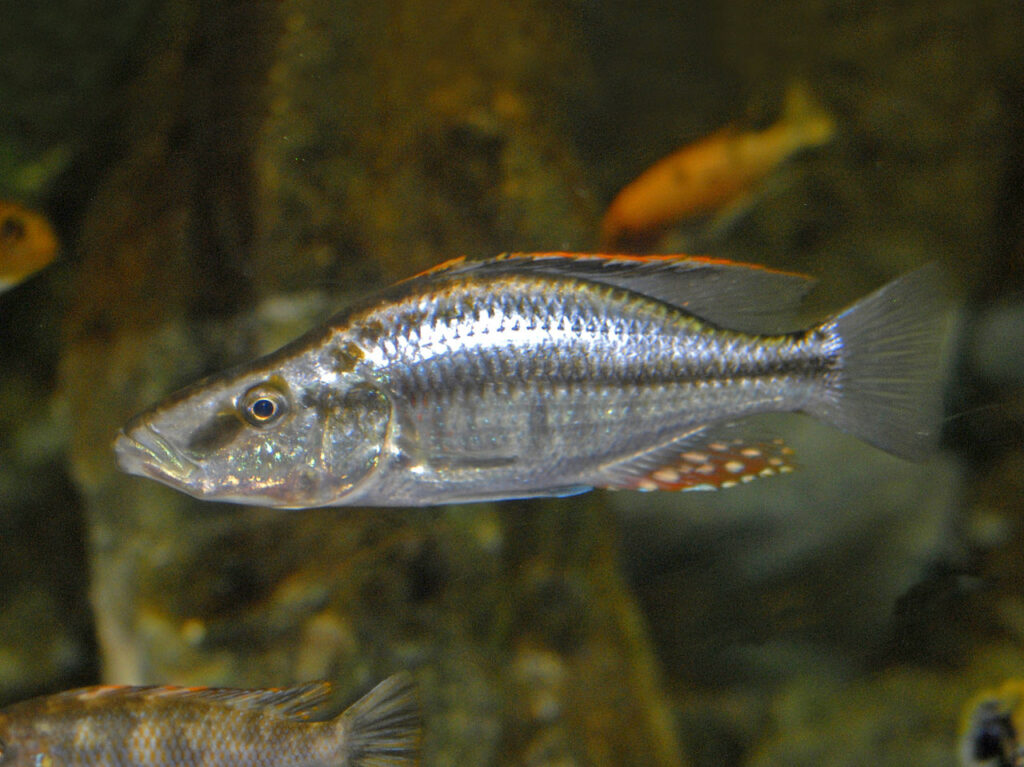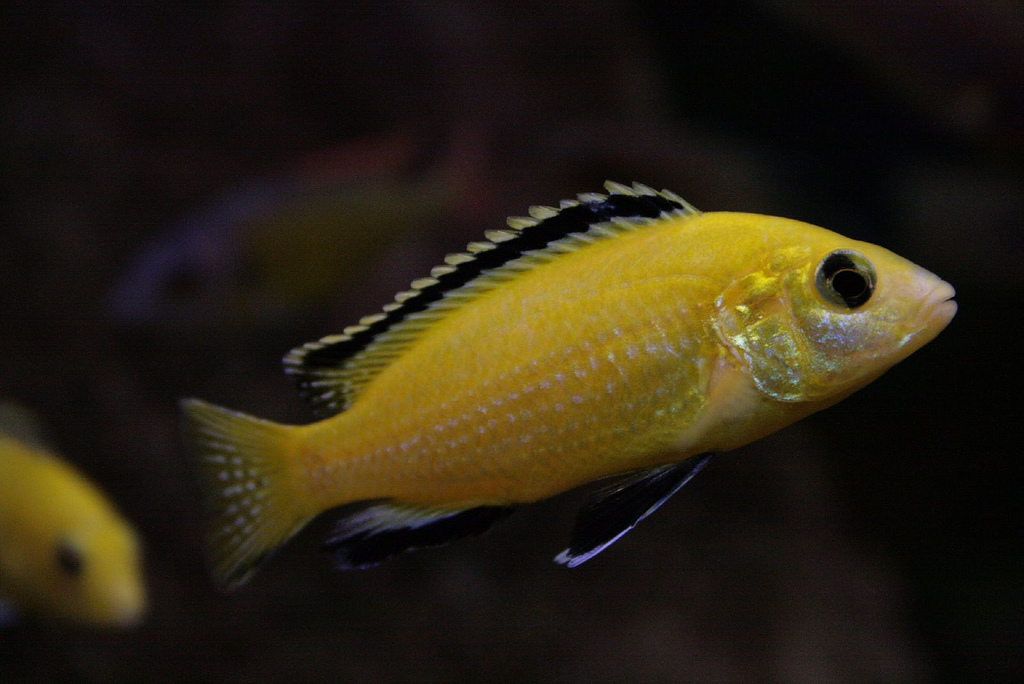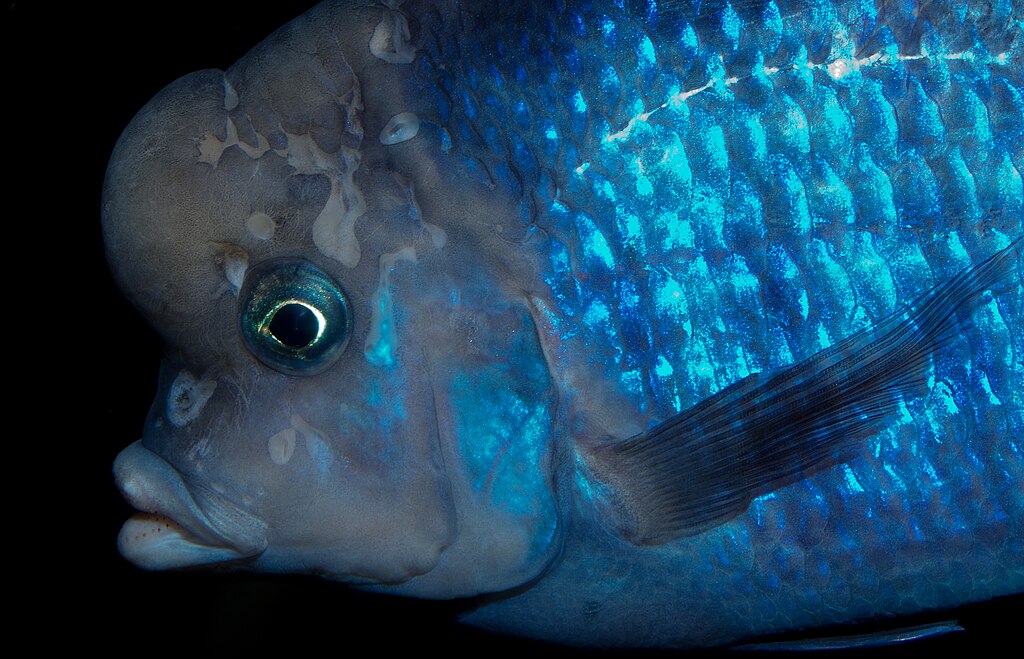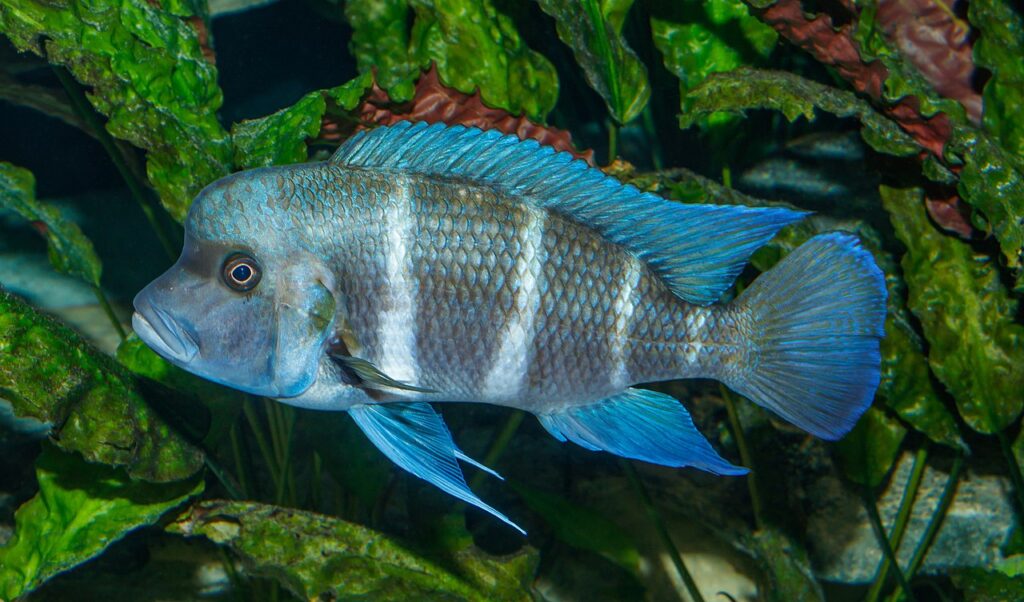The Malawi Eye Biter, scientifically known as Dimidiochromis compressiceps, is a fascinating fish species that has garnered attention among aquarists and researchers alike. This species belongs to the family Cichlidae, a diverse group of fish known for their vibrant colors and complex behaviors.
Table of Contents
One of the most interesting aspects of the Malawi Eye Biter is its unique feeding behavior. Contrary to its common name, which suggests that it bites the eyes of other fish, research has shown that this behavior is not as prevalent as once thought. In fact, studies have found that the Malawi Eye Biter is a generalist predator that feeds on small fish, including juvenile Utaka and other shoaling species.
The scientific name Dimidiochromis compressiceps is derived from the Latin words “dimidio,” meaning “half,” and “chromis,” referring to the fish’s coloration. The species name “compressiceps” refers to the fish’s laterally compressed body shape, which allows it to dart in and out of aquatic plants with ease[1].
In the aquarium trade, the Malawi Eye Biter is often referred to as the “Eyebiter” or “Compressiceps.” However, it’s essential to note that some species, such as Dimidiochromis strigatus, may be mislabeled as D. compressiceps due to their similar appearance[3].
In terms of habitat, the Malawi Eye Biter is found in vegetated areas of Lake Malawi, Lake Malombe, and the upper Shire River in East Africa. They are mid-dwellers, preferring to swim in the open waters rather than dwelling on the bottom or hiding in crevices[1][2].
Their diet consists mainly of small fish, which they catch using their large, protrusible mouths. In the aquarium, they can be fed a variety of foods, including whitebait, cockles, mussels, and cichlid pellets[3].
One of the most fascinating aspects of the Malawi Eye Biter is its breeding behavior. Males will excavate a shallow depression in the sand and display their vibrant colors to attract females. The females will then lay their eggs in the spawning site, and the males will release their milt to fertilize the eggs. The females will then take the eggs into their mouths and brood them for around three weeks before releasing the fry[1][5].
Research has also shed light on the developmental basis of phenotypic integration in the Malawi Eye Biter. A study published in the journal ResearchGate found that the species’ color pattern is determined by the interaction of three pigment cell types: melanophores, xanthophores, and iridophores.

Malawi Eye Biter Key Information
The Malawi Eye Biter is a stunning fish species that boasts vibrant colors and intricate patterns. Its body is a mesmerizing blend of blues, yellows, and blacks, with vertical stripes that seem to shimmer in the light. The fins and tail are adorned with bright yellow and orange hues, adding to the fish’s overall visual appeal. But beyond its stunning appearance, the Malawi Eye Biter is a fascinating species with unique characteristics and requirements.
| Family | Cichlidae |
| Origin | Lake Malawi, Lake Malombe, and the upper Shire River in East Africa |
| Price | $10-$20 |
| Common Names | Eyebiter, Compressiceps |
| Variants | None |
| Ideal Tank Size | 55 gallons or larger |
| Water Parameters | pH 7.8-8.6, Temperature 78-82°F, Hardness 10-20 dGH |
| Lifespan | 8-10 years |
| Full Size | 6-8 inches |
| Natural Environment | Vegetated areas of Lake Malawi and surrounding waters |
| Behavior | Aggressive, territorial |
| Habitat Preference | Mid-water dweller, prefers open swimming areas |
| Aquarium Decoration | Rocks, plants, and open swimming areas |
| Ideal Tank Mates | Other aggressive cichlids, such as Mbunas and Haplochromines |
| Fish to Avoid | Peaceful community fish, such as Neon Tetras and Guppies |
| Best Foods/Diet | Meaty foods, such as whitebait, cockles, and cichlid pellets |
| Disease | Susceptible to Malawi Bloat and other cichlid-specific diseases |
| Sex-switch | No |
| Gender Differences | Males have more vibrant colors and longer fins than females |
| Care Level | Advanced |
| Breeding Level | Expert |
Ideal Tank Mates for Malawi Eye Biter
When selecting tank mates for the Malawi Eye Biter (Dimidiochromis compressiceps), it’s important to consider their territorial and semi-aggressive nature. Ideal tank mates are those that can coexist peacefully without competing for the same space or resources. Here are ten specific species that are well-suited to share a tank with the Malawi Eye Biter:
1. Red Empress (Protomelas taeniolatus)
The Red Empress is a colorful and relatively peaceful cichlid, making it a great companion for the Malawi Eye Biter. Its calm demeanor and preference for different swimming levels help minimize territorial disputes.
| Common/Market Names | Red Empress |
|---|---|
| Price Range | $10-$30 |
| Care Level | Moderate |
| Behavior | Peaceful |
| Life Span | 5-10 years |
| Max Size | 6-8 inches |
2. Electric Blue Hap (Sciaenochromis ahli)
The Electric Blue Hap is known for its striking blue coloration and peaceful nature. It generally stays out of the way of more aggressive tank mates, making it suitable for cohabitation with the Malawi Eye Biter.
| Common/Market Names | Electric Blue Hap |
|---|---|
| Price Range | $15-$40 |
| Care Level | Moderate |
| Behavior | Peaceful |
| Life Span | 5-8 years |
| Max Size | 6-8 inches |
3. Yellow Lab (Labidochromis caeruleus)

The Yellow Lab is a popular choice due to its vibrant color and peaceful temperament. It tends to occupy different areas of the tank, reducing the likelihood of conflict with the Malawi Eye Biter.
| Common/Market Names | Yellow Lab |
|---|---|
| Price Range | $8-$20 |
| Care Level | Easy |
| Behavior | Peaceful |
| Life Span | 6-10 years |
| Max Size | 4-5 inches |
4. Livingstoni Cichlid (Nimbochromis livingstonii)
The Livingstoni Cichlid is known for its unique camouflage pattern and relatively peaceful nature. It can coexist with the Malawi Eye Biter, especially if the tank is spacious enough to allow for territories.
| Common/Market Names | Livingstoni Cichlid |
|---|---|
| Price Range | $10-$25 |
| Care Level | Moderate |
| Behavior | Semi-aggressive |
| Life Span | 7-10 years |
| Max Size | 10-12 inches |
5. Venustus Cichlid (Nimbochromis venustus)
The Venustus Cichlid is a large, peaceful fish that can hold its own in a tank with the Malawi Eye Biter. Its size and calm demeanor help it avoid becoming a target of aggression.
| Common/Market Names | Venustus Cichlid |
|---|---|
| Price Range | $15-$35 |
| Care Level | Moderate |
| Behavior | Semi-aggressive |
| Life Span | 5-10 years |
| Max Size | 10-12 inches |
6. Blue Dolphin Cichlid (Cyrtocara moorii)

The Blue Dolphin Cichlid is known for its distinctive hump and peaceful nature. It is a non-aggressive species that can peacefully coexist with the Malawi Eye Biter in a well-sized tank.
| Common/Market Names | Blue Dolphin Cichlid |
|---|---|
| Price Range | $10-$30 |
| Care Level | Moderate |
| Behavior | Peaceful |
| Life Span | 7-10 years |
| Max Size | 8-10 inches |
7. Frontosa Cichlid (Cyphotilapia frontosa)

The Frontosa Cichlid is a large, peaceful fish that can thrive alongside the Malawi Eye Biter. Its size and calm nature make it a suitable tank mate, provided the tank is spacious enough.
| Common/Market Names | Frontosa Cichlid |
|---|---|
| Price Range | $20-$50 |
| Care Level | Moderate |
| Behavior | Peaceful |
| Life Span | 10-15 years |
| Max Size | 12-14 inches |
8. Blue Peacock Cichlid (Aulonocara nyassae)
The Blue Peacock Cichlid is a peaceful species that adds a splash of color to the tank. Its non-aggressive nature makes it a good match for the Malawi Eye Biter.
| Common/Market Names | Blue Peacock Cichlid |
|---|---|
| Price Range | $10-$25 |
| Care Level | Easy |
| Behavior | Peaceful |
| Life Span | 6-8 years |
| Max Size | 4-6 inches |
9. Compressiceps Cichlid (Altolamprologus compressiceps)
The Compressiceps Cichlid is a unique species known for its compressed body shape. It is generally peaceful and can coexist with the Malawi Eye Biter if ample hiding spaces are provided.
| Common/Market Names | Compressiceps Cichlid |
|---|---|
| Price Range | $15-$40 |
| Care Level | Moderate |
| Behavior | Peaceful |
| Life Span | 8-10 years |
| Max Size | 4-5 inches |
10. Red Zebra Cichlid (Maylandia estherae)
The Red Zebra Cichlid is a hardy and colorful fish that can live with the Malawi Eye Biter. Its robust nature and ability to establish its own territory make it a suitable tank mate.
| Common/Market Names | Red Zebra Cichlid |
|---|---|
| Price Range | $8-$20 |
| Care Level | Easy |
| Behavior | Semi-aggressive |
| Life Span | 5-10 years |
| Max Size | 5-6 inches |
These species are chosen for their compatibility in terms of size, temperament, and habitat preferences, ensuring a harmonious environment in the aquarium.
FAQs about Malawi Eye Biter
What is the natural habitat of the Malawi Eye Biter?
The Malawi Eye Biter is native to Lake Malawi, Lake Malombe, and the upper Shire River in East Africa. It thrives in vegetated areas with plenty of open water for swimming.
How can I identify a male Malawi Eye Biter?
Male Malawi Eye Biters are typically more colorful than females, displaying vibrant blues and yellows. They also tend to have longer fins and a more pronounced body shape.
What should I do if my Malawi Eye Biter becomes aggressive?
If your Malawi Eye Biter becomes aggressive, consider rearranging the tank decorations to disrupt established territories. Providing plenty of hiding spaces and ensuring the tank is large enough can also help reduce aggression.
Can Malawi Eye Biters be kept in a community tank?
Yes, Malawi Eye Biters can be kept in a community tank with other cichlids of similar size and temperament. It’s important to avoid keeping them with smaller, more peaceful fish that may become targets of aggression.
What are the signs of illness in a Malawi Eye Biter?
Signs of illness in a Malawi Eye Biter include lethargy, loss of appetite, unusual swimming patterns, and visible spots or lesions on the body. It’s important to monitor your fish closely and seek veterinary advice if you notice any of these symptoms.
How often should I feed my Malawi Eye Biter?
Malawi Eye Biters should be fed once or twice a day, depending on their size and activity level. It’s important to provide a varied diet that includes high-quality cichlid pellets and occasional treats like live or frozen foods.
What is the ideal water temperature for a Malawi Eye Biter?
The ideal water temperature for a Malawi Eye Biter is between 78-82°F (25-28°C). Maintaining stable water conditions is crucial for their health and well-being.
How can I tell if my Malawi Eye Biter is stressed?
Signs of stress in a Malawi Eye Biter include rapid gill movement, hiding, loss of color, and unusual behavior. Ensuring proper tank conditions and avoiding sudden changes can help reduce stress.
What is the best way to clean a Malawi Eye Biter’s tank?
Regular water changes and substrate vacuuming are essential for maintaining a clean tank. It’s important to avoid using harsh chemicals and to rinse any decorations or equipment with dechlorinated water.
Can Malawi Eye Biters be bred in captivity?
Yes, Malawi Eye Biters can be bred in captivity, but it requires careful attention to water conditions and tank setup. Providing a separate breeding tank with optimal conditions can increase the chances of successful breeding.